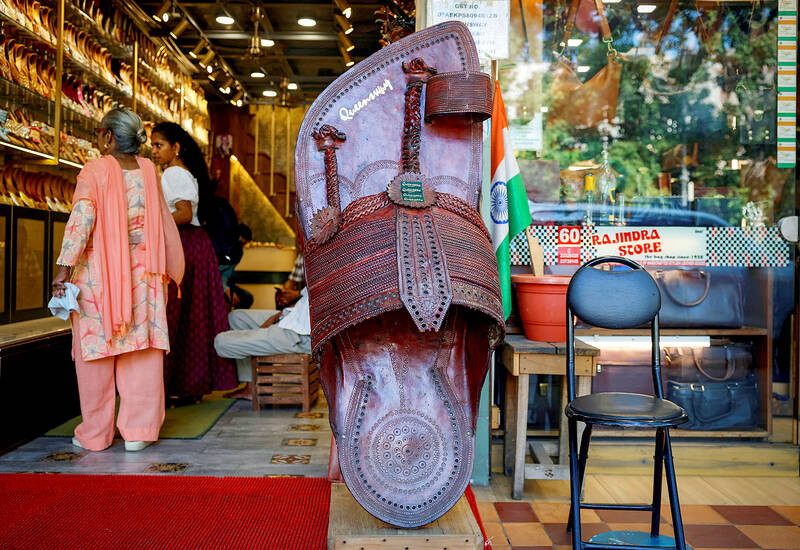Luxury fashion powerhouse Prada SpA has acknowledged the ancient Indian roots of its new sandal design after the debut of the open-toe footwear sparked a furor among Indian artisans and politicians thousands of miles from the catwalk in Italy.
Images from Prada’s fashion show in Milan last weekend showed models wearing leather sandals with a braided design that resembled handmade Kolhapuri slippers with designs dating back to the 12th century.
A wave of criticism in the media and from lawmakers followed over the Italian brand’s lack of public acknowledgement of the Indian sandal design, which is named after a city in the western state of Maharashtra in India.

Photo: Reuters
Lorenzo Bertelli, son of Prada’s owners, responded to the sandal scandal in a letter to a trade group on Friday recognizing their Indian heritage.
“We acknowledge that the sandals... are inspired by traditional Indian handcrafted footwear, with a centuries-old heritage,” Bertelli, Prada’s head of corporate social responsibility, wrote in the letter to the Maharashtra Chamber of Commerce, seen by Reuters.
The sandals are at an early stage of design and it is not certain they would be commercialized, but Prada is open to a “dialogue for meaningful exchange with local Indian artisans” and would arrange follow-up meetings, he wrote.
A Prada spokesperson issued a statement acknowledging the sandal’s inspiration from India, adding that the company has “always celebrated craftsmanship, heritage and design traditions.”
Prada products are beyond the reach of most Indians. Its men’s leather sandals retail for US$844 and up, while the Kolhapuri slippers, sold in Indian shops and street markets, start at about US$12.
India’s luxury market is small, but growing fast, with rising numbers of rich people buying Louis Vuitton bags, Lamborghini cars, luxury homes and watches.
Conversely, Indian culture and crafts are increasingly finding their way into global brand designs. High-end jeweler Bulgari offers a US$16,000 Mangalsutra necklace inspired by a chain traditionally worn by married women.
Bertelli’s homage to Indian design was sent in a response to a complaint from the head of the trade group that represents 3,000 Kolhapuri sandal artisans, as the online uproar gathered momentum.
“From the dusty lanes of Kolhapur to the glitzy runways of Milan... will the world finally give credit where it’s due?” India’s DNA News wrote on social media.
Sambhaji Chhatrapati from the former royal family of Kolhapur told Reuters by phone he was upset that craftsmen had not been acknowledged for the “history and heritage of 150 years.”
Kolhapur-based businessman Dileep More, however, said images of the Prada sandal were bringing cheer to some artisans as they show their traditional product going global.
“They are happy that someone is recognizing their work,” he said.

Mercuries Life Insurance Co (三商美邦人壽) shares surged to a seven-month high this week after local media reported that E.Sun Financial Holding Co (玉山金控) had outbid CTBC Financial Holding Co (中信金控) in the financially strained insurer’s ongoing sale process. Shares of the mid-sized life insurer climbed 5.8 percent this week to NT$6.72, extending a nearly 18 percent rally over the past month, as investors bet on the likelihood of an impending takeover. The final round of bidding closed on Thursday, marking a critical step in the 32-year-old insurer’s search for a buyer after years of struggling to meet capital adequacy requirements. Local media reports

TECHNOLOGICAL RIVALRY: The artificial intelligence chip competition among multiple players would likely intensify over the next two years, a Quanta official said Quanta Computer Inc (廣達), which makes servers and laptops on a contract basis, yesterday said its shipments of artificial intelligence (AI) servers powered by Nvidia Corp’s GB300 chips have increased steadily since last month, should surpass those of the GB200 models this quarter. The production of GB300 servers has gone much more smoothly than that of the GB200, with shipments projected to increase sharply next month, Quanta executive vice president Mike Yang (楊麒令) said on the sidelines of a technology forum in Taipei. While orders for GB200 servers gradually decrease, the production transition between the two server models has been

US sports leagues rushed to get in on the multi-billion US dollar bonanza of legalized betting, but the arrest of an National Basketball Association (NBA) coach and player in two sprawling US federal investigations show the potential cost of partnering with the gambling industry. Portland Trail Blazers coach Chauncey Billups, a former Detroit Pistons star and an NBA Hall of Famer, was arrested for his alleged role in rigged illegal poker games that prosecutors say were tied to Mafia crime families. Miami Heat guard Terry Rozier was charged with manipulating his play for the benefit of bettors and former NBA player and

BETTER THAN EXPECTED: The firm’s Q3 results exceeded its projections, based on ‘the underlying strength of our core markets,’ chief financial officer Dave Zinsner said Intel Corp returned to profitability and gave an upbeat revenue forecast after PC demand grew, suggesting that it is making progress on a long and challenging comeback attempt. In the third quarter, revenue rose 3 percent to US$13.7 billion. The Santa Clara, California-based company posted its first quarterly net income since the end of 2023, with earnings per share of US$0.23, excluding some items. Analysts had estimated sales of US$13.2 billion and earnings per share of US$0.01 on average, according to data compiled by Bloomberg. Fourth-quarter sales would be roughly US$13.3 billion, the company said in a statement on Thursday. Intel shares gained about